-
Medical journals
- Career
Endovascular treatment of iliofemoral deep venous thrombosis
Authors: J. Bezecny 1; D. Kučera 1,2; M. Válka 1; J. Kozák 1; V. Jetmar 1; J. Krátký 1
Authors‘ workplace: Vaskulární centrum, Vítkovická nemocnice a. s., Ostrava 1; II. interní klinika kardiologie a angiologie 1. LF UK a VFN v Praze 2
Published in: Kardiol Rev Int Med 2016, 18(3): 195-198
Overview
Thromboembolic disease and its complications can be life threatening. Chronic proximal deep venous thrombosis can lead to the development of post-thrombotic syndrome. Conservative therapy with anticoagulation is effective in preventing negative outcomes. It does not, however, lead to thrombus dissolution, although it stops its growth. The recanalisation is therefore spontaneous, resulting from the fibrinolytic ability of human tissues and thrombus remodelling. Percutaneous trans-catheter treatment of DVT patients involves thrombus removal using local thrombolysis, mechanical thrombectomy, angioplasty, and stenting of venous stenosis or obstruction. Local thrombolytic therapy can be recommended for symptomatic patients with low risk of bleeding. Mechanical recanalisation can cause injury to the vessel wall, valves or be insufficient in thrombus removal. Although no large, prospective, randomised studies comparing anticoagulation and interventional treatment of proximal DVT have been conducted so far, interventional treatment has its place and can be considered in certain clinical situations.
Keywords:
deep venous thrombosis – interventional treatment
Sources
1. Jiménez D, Díaz G, Marín E et al. The risk of recurrent venous thromboembolism in patients with unprovoked symptomatic deep vein thrombosis and asymptomatic pulmonary embolism. Thromb Haemost 2006; 95 : 562–566.
2. Monreal M, Lafoz E, Casals A et al. Occult cancer in patients with deep venous thrombosis: a systematic approach. Cancer 1991; 67 : 541–545.
3. Nordstrom M, Lindblad B, Bergqvist D et al. A prospective study of the incidence of deep-vein thrombosis within a defined urban population. J Intern Med 1992; 232 : 155–160.
4. Vedantham S, Sista AK, Klein SJ et al. Quality improvement guidelines for the treatment of lower-extremity deep vein thrombosis with use of endovascular thrombus removal. J Vasc Interv Radiol 2014; 25 : 1317–1325. doi: 10.1016/j.jvir.2014.04. 019.
5. Kearon C. Natural history of venous thromboembolism. Circulation 2003; 107 (Suppl): 22–30.
6. Schreiber D. Percutaneous transcatheter treatment of deep venous thrombosis. Medscape 2015. Available from: http: //emedicine.medscape.com/article/1921338-overview.
7. Kearon C, Akl EA, Ornelas J et al. Antithrombotic therapy for VTE disease: CHEST Guideline and Expert Panel Report. Chest 2016; 149 : 315–352. doi: 10.1016/j.chest.2015.11.026.
8. Holý M. Syndrom pánevní kongesce. Kardiol Rev Int Med 2014, 16 (4): 321–329.
Labels
Paediatric cardiology Internal medicine Cardiac surgery Cardiology
Article was published inCardiology Review

2016 Issue 3-
All articles in this issue
- A complete endovascular revascularisation of atherothrombotic occlusion of popliteal artery and below-the-knee arteries in a polymorbid patient – a case report
- Endovascular treatment of iliofemoral deep venous thrombosis
- Beta-blockers with the smallest negative impact on cardiorespiratory fitness in healthy people
- Project MedPed – spotlight on patients with familial hypercholesterolaemia
- Significance of periprocedural decrease in left ventricular outflow tract gradient after alcohol septal ablation in patients with hypertrophic obstructive cardiomyopathy
- Endovascular treatment of cerebrovascular accident
- Results of endovascular treatment and management of carotid stenosis at the Vítkovice Hospital
- Endovascular treatment of type B aortic dissection and ischaemic complications accompanying aortic dissections
- Type B aortic dissection with severe visceral and limb ischaemia treated with a complete endovascular revascularisation – a case report
- Possibilities of endovascular treatment of acute limb ischaemia
- Organisation of podiatric care in patients with critical limb ischaemia
- Cardiology Review
- Journal archive
- Current issue
- Online only
- About the journal
Most read in this issue- Beta-blockers with the smallest negative impact on cardiorespiratory fitness in healthy people
- Endovascular treatment of iliofemoral deep venous thrombosis
- Possibilities of endovascular treatment of acute limb ischaemia
- Type B aortic dissection with severe visceral and limb ischaemia treated with a complete endovascular revascularisation – a case report
Login#ADS_BOTTOM_SCRIPTS#Forgotten passwordEnter the email address that you registered with. We will send you instructions on how to set a new password.
- Career

